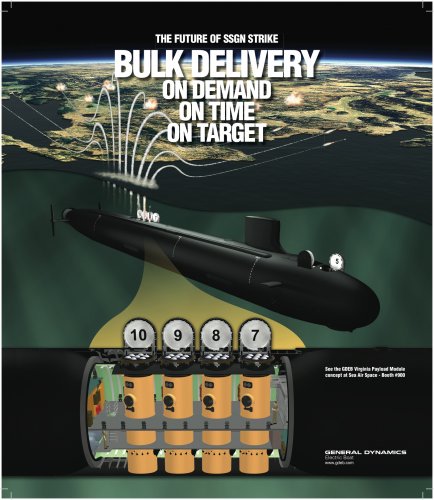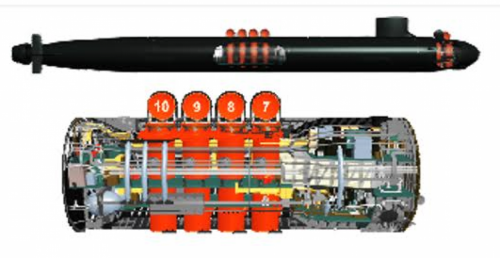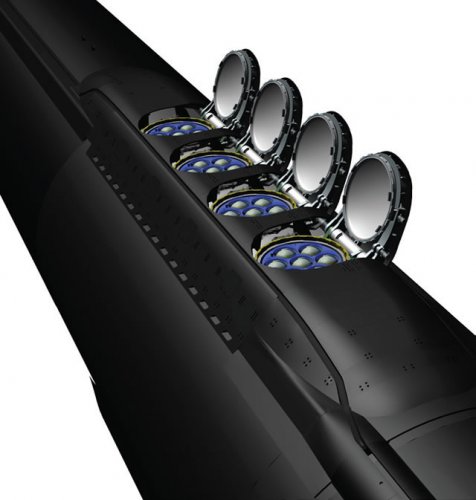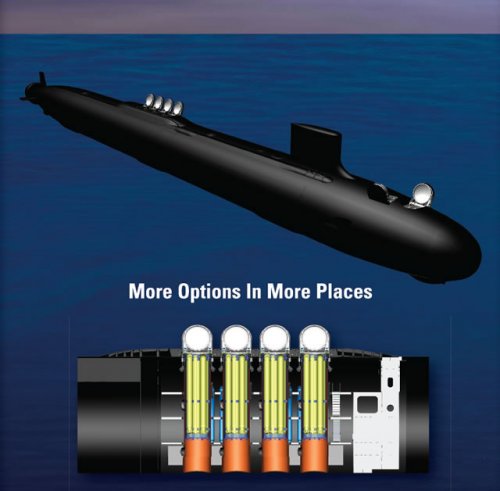- Joined
- 21 April 2009
- Messages
- 13,759
- Reaction score
- 7,700
From Defensetech.org:
A New Breed of Guided Missile Sub May Be Emerging
In case you haven’t seen this, submarine maker Electric Boat is pitching the idea of building a stretched Virginia class attack sub capable of carrying up to 194 Tomahawk cruise missiles. Basically, a 90-foot plug would be put into new boats, allowing them to triple the number of guided missiles they carry. And yes, it would add $500 million or 20 percent to the overall cost of a Virgnia class boat, but it could be a relatively easy way to make up for the late-2020s retirement of the four-Ohio class boomers that have been converted into guided missile subs.
The Navy’s Submarine Force will lose about 60 percent of its undersea firepower in the late 2020s with the retirement of its four guided-missile subs, capable of carrying up to 154 Tomahawk missiles. This is happening at the same time that the number of attack submarines in the fleet is dropping because of the retiring of the aging members of the Los Angeles-class subs. The first “stretch” Virginia could be the sub that EB starts building in 2019, which would be commissioned close to the time that the first guided-missile sub retires. On the most recent Virginia-class subs, two large-diameter missile tubes located forward of the sail can launch six Tomahawk cruise missiles each. The subs also carry torpedoes. Extending the submarine to 471 feet would make room for a module near the middle with four additional tubes capable of launching seven missiles each. That would be a 230 percent jump in the number of Tomahawks that can be launched quickly, from 12 to 40.
While the new subs will have to compete budget-wise with the Navy’s Ohio class replacement effort, SSBN-X, sticking lots of missiles on one ship could save a serious amount of operations cash, as the article points out: Peter W. Singer, director of the 21st Century Defense Initiative and a senior fellow in foreign policy at the Brookings Institution, said the stretch Virginia seeks to answer a key problem that the Navy faces, the crunch in the number of submarines overall and the limits in the number of missiles they can deploy. Both problems look to be worsening in the future, he added.
“The Navy is going to face a series of tough decisions budgetwise. But all things being equal, it’s a program we have to give serious consideration towards,” Singer said Tuesday. The USS Florida was one of the three U.S. submarines that launched Tomahawk missiles into Libya last month to support a no-fly zone. One of the fleet’s four guided-missile submarines, the Florida launched a majority of its Tomahawk missiles, Breckenridge said. Typically, guided-missile submarines deploy with 105 missiles, he added. “The Navy would’ve needed eight other attack subs in theater to do what that one ship, Florida, did,” he said. Apparently, the Navy asked Electric Boat to look into the idea a couple of years ago and EB says that it could have the first modified Virgina class sub under construction by 2019.
A New Breed of Guided Missile Sub May Be Emerging
In case you haven’t seen this, submarine maker Electric Boat is pitching the idea of building a stretched Virginia class attack sub capable of carrying up to 194 Tomahawk cruise missiles. Basically, a 90-foot plug would be put into new boats, allowing them to triple the number of guided missiles they carry. And yes, it would add $500 million or 20 percent to the overall cost of a Virgnia class boat, but it could be a relatively easy way to make up for the late-2020s retirement of the four-Ohio class boomers that have been converted into guided missile subs.
The Navy’s Submarine Force will lose about 60 percent of its undersea firepower in the late 2020s with the retirement of its four guided-missile subs, capable of carrying up to 154 Tomahawk missiles. This is happening at the same time that the number of attack submarines in the fleet is dropping because of the retiring of the aging members of the Los Angeles-class subs. The first “stretch” Virginia could be the sub that EB starts building in 2019, which would be commissioned close to the time that the first guided-missile sub retires. On the most recent Virginia-class subs, two large-diameter missile tubes located forward of the sail can launch six Tomahawk cruise missiles each. The subs also carry torpedoes. Extending the submarine to 471 feet would make room for a module near the middle with four additional tubes capable of launching seven missiles each. That would be a 230 percent jump in the number of Tomahawks that can be launched quickly, from 12 to 40.
While the new subs will have to compete budget-wise with the Navy’s Ohio class replacement effort, SSBN-X, sticking lots of missiles on one ship could save a serious amount of operations cash, as the article points out: Peter W. Singer, director of the 21st Century Defense Initiative and a senior fellow in foreign policy at the Brookings Institution, said the stretch Virginia seeks to answer a key problem that the Navy faces, the crunch in the number of submarines overall and the limits in the number of missiles they can deploy. Both problems look to be worsening in the future, he added.
“The Navy is going to face a series of tough decisions budgetwise. But all things being equal, it’s a program we have to give serious consideration towards,” Singer said Tuesday. The USS Florida was one of the three U.S. submarines that launched Tomahawk missiles into Libya last month to support a no-fly zone. One of the fleet’s four guided-missile submarines, the Florida launched a majority of its Tomahawk missiles, Breckenridge said. Typically, guided-missile submarines deploy with 105 missiles, he added. “The Navy would’ve needed eight other attack subs in theater to do what that one ship, Florida, did,” he said. Apparently, the Navy asked Electric Boat to look into the idea a couple of years ago and EB says that it could have the first modified Virgina class sub under construction by 2019.





